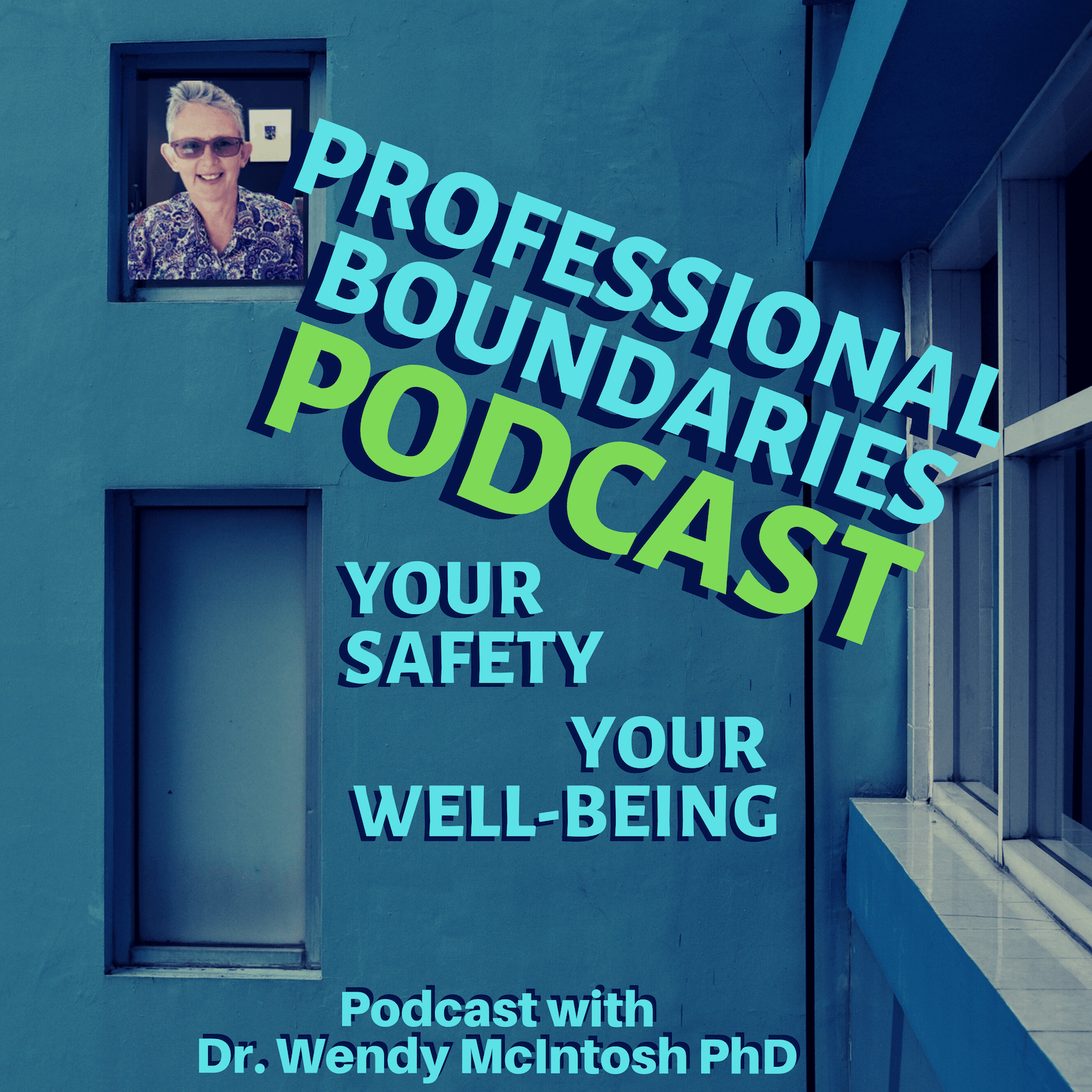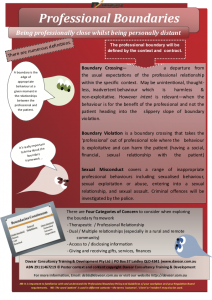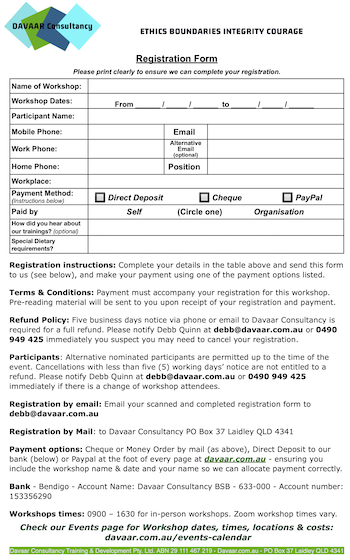Podcast: Play in new window | Download (Duration: 34:13 — 23.3MB)
Subscribe: Apple Podcasts | Spotify | TuneIn
Episode 2 – Professional Boundaries: Your safety, your well-being

In the Professional Boundaries Podcast – Episode 2 – Definitions and language of Professional Boundaries, Dr. Wendy McIntosh PhD from Davaar Consultancy shares a potential Professional Boundaries crossing scenario from her own nursing career, revealing some of the risks of crossings and transgressions when working with clients, customers, patients, and colleagues.
In this episode, boundary crossings are explained, and how they can so easily slide along the over-involvement and under-involvement continuum into transgressions and some of the reasons why. Wendy also begins the talk about Red flags – what they might signify, and how to spot them.
Listen as Dr. Wendy continues her discussion on maintaining Professional Boundaries, and why the context of the relationship is so important. This is the second part of a dialogue that be will be continued in the following episodes. Use the links above to subscribe, or click the play button to listen. Listen to Episode 3 about the Professional Boundaries Framework here.
There are 6 episodes planned in this first season of the Professional Boundaries Podcast and we hope you’ll be back to enjoy and learn from each of them. If you’ve ever wondered about your own Professional Boundaries behaviour, or been alerted about the risks of crossings or violations, this podcast will help you learn what to watch for, and ways to stay out the danger zones.
Dr. Wendy McIntosh welcomes both your interest and curiosity. Send Wendy questions at wendy@davaar.com.au

Dr. Wendy McIntosh PhD
Since 2005 Wendy has been developing her knowledge and interest in the area of professional boundaries. Wendy delivers workshops on boundaries in Australia (where she now lives) and Internationally when invited to do so. She is continually integrating learning and insights she gains from the work she does in professional boundaries. Wendy comes from a nursing, and predominately psychiatric nursing, background.
Wendy consistently receives feedback on her passion, knowledge, and creativity as a presenter and facilitator. Enjoy exploring boundaries in this podcast series as Wendy takes you on your own reflective journey on your professional boundaries.
References:
Music clips in this podcast:
“Perspectives” by Kevin MacLeod (https://incompetech.com) &
“Middle Earth ” by Jason Shaw (https://audionautix.com)
License: CC BY (http://creativecommons.org/licenses/by/4.0/)
Transcript: Podcast Two – Definitions and language of professional boundaries
Scenario She had a history of self-harming. Banging her head on walls was one form of self-harm that caused distress to the patient and to staff looking after her. One shift I was in a room with her, she was my allocated patient – she made a quick movement towards a wall. I also moved quickly and put my body between the patient and the wall. I asked her to stop moving She did Neither of us were hurt, both of us could have been. My self-assessment – Wendy that was a thoughtless careless action you just did Her assessment – someone cared enough about her to put their life on the line for her We were worlds apart in our assessment of what had happened….. or were we?
Welcome to this Podcast series – Professional Boundaries, Your safety, your wellbeing.
I am Wendy Mcintosh from Davaar Consultancy and I am delighted that you are joining me on another journey of exploration, revelation and for some, consolidation on the theme of professional boundaries. This podcast series focuses on you and ways in which Professional Boundaries can assist you in the everyday work that you do. I have planned for six podcasts and I stay open to producing more as required. We plan to have a new podcast each week. I would love to have your input through questions, scenarios to explore, reflections from each podcast.
One of my aims for these podcasts is to have you engaged in this process with me. I know from experience that having discussions about boundaries and what it means for us in the work and services we provide is an important step in assisting us understand motivations for our actions. Contact details are provided at the end of this podcast.
Family, friends, and colleagues who have travelled with me over many years frequently identify what they refer to as Wendyisms. Words, sentences, a way of speak that emerges from me at different times when I yarn. I envisage there will be a few Wendyisms that present in these podcasts. Enjoy them when you hear them.
This is our second podcast and following from the first one, today’s session focusses on definitions and language used to assist us to explore, explain and understand what professional boundaries mean for you and the work you do. There will be four main definitions which I will tease out in this podcast these are: boundary transgressions, boundary crossings, boundary violations, and sexual misconduct.
Victor Frankel – stated – Between the stimulus and response, there is a space. In that space is our power to choose. In the scenario just presented, I did not create enough space to make a conscious choice. I reacted to some old response in me that I could not fully understand at the time. In reality, it took me many years of working in this space of professional boundaries before I had my “ah ha” moment. Before I could really appreciate whose needs were being met by my actions. We can only know what we know – until we learn something different.
Like many participants I work with I have wrestled with the definitions used in professional boundaries. I have had to dissect many scenarios, be challenged by many folks, and have read much literature in order for me to reach a place where I can say with some certainty – yes that was or that was not a boundary transgression. Yes, that was a violation, not a crossing or vice versa. I trust that this session will assist you the listener understand the definitions and to make sense of them in order that you may integrate them into your work. I believe that when we understand the definitions we can also have a different dialogue with colleagues about potential or actual transgressions that they have done. Individual interpretation of what constitutes professional boundaries can be problematic especially when social and professional contexts change.
Gardner & McCutcheon (2016 p33) argued that “Professional boundaries are constructed social phenomena that are open to interpretation, individuals within a defined professional group may have different expectations to their colleagues”. These authors argued that professional groups and regulator bodies may struggle to determine what constitutes a professional boundary transgression.
What follows are some comments from participants who completed boundary training with me either one to one, in workshops or through our online tool on boundaries. I see that the comments also highlight that sometimes individuals don’t know what they don’t know until they learn something new. From one participant, “Prior to commencing this course, my understanding of professional boundaries was indeed very limited. My understanding was only based on over-involvement crossings with no clear divide in my mind between boundary violations and boundary crossings” another participant “Having completed the online course, my understanding about professional boundaries is that boundary violations in working relationships is one of the more difficult ethical dilemmas you may be confronted with”. And finally “Prior to commencing this training my understanding of professional boundaries was blurred, I knew that boundaries existed …. I was reliant on watching the clinicians around me which offered a wide variance of acceptable boundaries. In retrospect, I see there were quite a few transgressions occurring”.
I argue that understanding the definitions of professional boundaries can enable us to be mindful of the spaces we are in, of the choices we make. To start our exploration about definitions there is some benefit in considering – what constitutes a boundary? A boundary is a border, an edge that marks the limits of an area. In the therapeutic relationship a boundary is the edge of appropriate behaviour at a given moment between the professional and the patient. If you reflect on your professional role, your workplace, your social group, your volunteer group – what is or are the borders that define the expectations of your role or roles? Interacting with other people means there will be many grey areas. The borders of the relationship may not be as clear cut as say the edges of lawn or the coastline around an island.
If you struggle with identifying the boundaries of your professional relationship then clear guidelines, role modelling, and clear professional expectations can assist you to stay safe. I reflect that if I wander aimlessly to the edge of a cliff and do not pay attention to where my next step takes me – it could be dangerous for me. I could fall off the cliff. Who knows what the consequences could be. Likewise wandering aimlessly in a professional relationship (be that professional to customer, or collegially) could take a person to the professional edge of safety and the next step could have serious consequences for both people in the relationship.
The most common definition of professional boundaries found in the literature is the “limits which protect the space between the professional’s power and the client’s vulnerability” (NMBA Guidelines 2010). According to Farmer, (2017) in health, the perception of a client’s vulnerability is deeply rooted in history with the professional being recognised as having the power, the influence, access to information about the client and their family and specialised knowledge, skills and at times a professional language. The power invested in the professional occurs through legislative, professional and organisational requirements.
Transgression refers to an act that goes against a law, rule, or code of conduct and there will be situations were transgressions could be a criminal offense. Professional boundary transgressions happen along a continuum between over and under involvement with clients (and in some instances family members of the client). The transgressions can be either crossings or violations or a combination of both. Professional boundary transgressions can also occur between colleagues. So let’s explore the three main boundary transgressions cited in the literature, boundary-crossing, boundary violation, and sexual misconduct.
Professional boundary crossings are considered to be a departure from the usual norms of the specific professional relationship they are – “brief excursions across boundaries that may be inadvertent, thoughtless or even purposeful if done to meet a special therapeutic care or need”. Crossings are considered to be harmless and non-exploitive. A crossing occurs once, a mistake, generally considered to be an unconscious mistake without intention to cause harm to the client. When a behaviour occurs more than once it is no longer a mistake, it is nor longer a crossing. Repeated behaviour is a pattern and in the burrowing we find intent. Repeated boundary crossings should be avoided this includes either crossings with the same client and /or repeated behaviour by the professional with a number of clients.
Professional boundary violations are not done for the well-being of the client and can result in significant harm to the client, violations – can result when the professional confuses their needs with the needs of the person in their care. In a violation, there is exploitation of the vulnerability of the client. A violation can occur in one event, or even in the initial encounter between a professional and the other person. Or a violation can be a series of encounters over a period of time, in some reported cases over many years. In a violation, the needs of the professional are more important than the needs of the client.
There is quite a list of needs to examine when considering professional violations. These include and are not limited to: physical, psychological, sexual, emotional financial. I will discuss these needs in greater detail in podcast three. There is a slippery slope between a crossing and a violation. The slippery slope can be as short as a couple of seconds or as long as weeks or months.
Sexual misconduct is generally preceded by relatively minor boundary transgressions and is “an extreme form of boundary violation which includes behaviour that is seductive, sexually demeaning, harassing or reasonably interpreted as sexual by the person who is the recipient of the behaviours from the professional.
So a couple of take-home points about crossings and violations. Crossings occur once Sometimes a crossing can be in the best interests of the client. And as I say to folks I do boundary work with – have good data that supports your rationale for the boundary-crossing you did. Violations can be a one-off event or a pattern of behaviour Violations are never alright Violations are never in the best interests of the client.
A theme consistently challenging for participants I see is where they have conducted what they assessed to be an Act of Kindness with a client. When that act is viewed by others – be that the professional’s supervisor, their regulatory body, the customer or family member of the customer – as a boundary transgression this can create a dissonance for the professional. The greyness of boundaries means that much will depend on the interpretations of witnesses to the behaviours in the context of the relationship or roles between the two people concerned. Context is important.
This is an area of struggle for professionals I see. They are astonished, angered, appalled and many feel ashamed to experience that what they considered and perceived to be a kind act, done for good and for the benefit of the customer, can be viewed by others as a boundary transgression. I believe that generally when a professional interacts with a customer they are not always considerate of how many people can be affected by those interactions.
I say to participants that I work with, in any interaction with a customer there are more than the two of you in the room. There are many other people who have a vested interest in how you are conducting yourself in that relationship. You just cannot see those other people sitting in the room with you, they do however have a presence in that relationship you are engaged in. There are many perceived acts of kindness, that have taken professionals to the edge of the border. Caught in time the individual is able to walk back from the edge and find someone to talk with about what they have been doing. With guidance and support from team leaders and supervisors, they have been able to do what I term recalibrate the relationship with the customer. For others stepping over the edge has come at a cost for them, their families and for the customer and their families. Context is important.
Acts of kindness can range from buying some extra food for a client with the professional’s own money to allowing a client to stay in their home to avoid homelessness. Another example could be when a client is in distress and tearful and even although the allocated time is up and there are other clients waiting to be seen, kindness is there to stay with the distressed client longer, however that can result in a negative outcome for the client who is now waiting to be seen. The kindness might be giving a movie card to a young person to go to the movies because the professional knows how much going to the movies means for that young person. The card is given as a gift and a comment “here you go enjoy this”.
Finally, an act of kindness, fuelled by a knowing that the elderly client loves roses, loves the smell and the colours of roses. The client talks about how much roses bring back many fond memories of their childhood. The professional also loves roses, loves the smell and grows roses and frequently presents the client with a bunch of freshly cut roses from his / her garden for the client to enjoy. The professional then enjoys the enjoyment of the client. But what I hear you say is wrong with giving a client roses from the professionals garden? My response at this point is to say, Context is important. And I invite you to take time to consider the question – whose needs are being met in the act of presenting the roses. First default – the client’s needs – they love roses. Roses bring back fond childhood memories. What’s not to applaud in the act of the professional when he/she gives the roses to the elderly client.
Remembering that boundaries are as complex as they are simple – what other intents could be there if we burrow down further. We will explore the act of giving and receiving gifts (which the roses are) in podcast three when we explore categories of concern. These acts of kindness can take people to the edges, to the borders of the professional relationship placing both people at risk of consequences that can not yet be visualised, perhaps not even conceptualized. Context is important.
Some crossing may be alright if it is in the best interest of the customer at the time. A crossing occurs once, a violation is a pattern of behaviour. Context is important. So using the definitions that we now have let’s explore that scenario at the beginning of this podcast. I want to introduce you to four main boundary questions that I consider to be essential in exploring an individual’s actions to assist determine – was that a transgression and if so – was it a crossing or a violation?
The four questions are: What was/is the intent or the purpose of the action / the content of the speech? Whose needs are/were being met? Were/are there other options available? (Generally, there will be a minimum of five options for each event) And the question I believe is essential – what stopped the person using another option? And don’t worry I will be repeating these questions numerous times in future podcasts.
What was my intent when I put my body between the patient and the wall? First default – to stop the patient harming herself Burrow down – I did not want her to hurt herself whilst I was “looking after her” Whose needs were being met? First default – the patient, I did not want her to harm herself. Burrow down – I was distressed, I did not know what to do, I had to do something. Did I have other options available to me? Always – I could have used my voice earlier, I could have let her go to the wall and maybe she would have started hurting herself or not, I could have pressed the emergency buzzer, I could have discussed options with the patient earlier in the shift – if this happens whilst I am in the room what could we do? I could have yelled STOP
What stopped me using another option? When I really burrow down – the assessment of the patient was correct – I did care enough about her to put my life on the line. I did care enough about her to put my life on the line. Let me just reflect here a bit longer with you adding some further context to the scenario. I had provided nursing care for this patient over many shifts. I did not realise at the time, not did colleagues talk with me about the potential of my becoming over-involved with her. At this time in the early 1990s we did not have the depth of information that we now have on childhood trauma and the impact for an individual’s development through life.
We knew very little about vicarious trauma or compassion fatigue, the term empathetic distress had not yet entered the professional language. I was experiencing what has been referred to by some authors as the empathy of pain. The patient’s pain, my pain. I experienced her pain and I wanted to be the one who could help stop her pain, I would do just about anything to assist her in her flashbacks, her intrusive thoughts, her painful emotions. In that brief yet highly significant couple of seconds – my caring about her was to put my life on the line. In retrospect when I burrow down deeper – the distress I wanted to ease, the person I wanted to save was myself. What I did not realise at that time was that my experiencing the empathy of pain was a red flag that I was becoming over-involved, over-invested in her care, her wellbeing.
I did not realise then that had I listened to, had I paid attention to the red flag, I may have chosen to act differently in the space that was there. I will discuss and give examples of red flags in more detail in podcast four. And here’s another question that I want to pose, was I really experiencing empathy?
Really what is empathy? How does empathy play out in the relationships we have with others? To me, empathy and boundaries have such an exquisite relationship that does require time to consider in detail. We will venture into empathy more when we discuss reasons for boundary transgressions in a future podcast. There I will return to the question was I really experiencing empathy in this scenario? If not empathy what was happening for me? Burrowing down, was there something in the patient’s story that resonated with my story? In that flash of time, what I refer to as a nanosecond or a split second, in that flash where a decision was made – there was a walking towards that edge, actually a running, I moved fast, the edge of the professional relationship.
It was fortunate that neither of use were physically hurt by my actions. However, there were other consequences that neither of us could have imagined from that couple of seconds of transgressions for me. Did I walk over, did I walk back? We’ll find out in podcast five.
I am enjoying my journey of writing these podcasts. Each time I write and reflect a deeper understanding occurs for me. I look forward to sharing session three with you where we will delve into the boundary framework in greater depth. In that session, we will explore Categories of Concern and Over and Under involvement. I will present some scenarios to you and ask you to put on your “Sherlock Holmes Professional Boundary curious hat”– what answers will you come up with as you start to integrate your learning from foundation stones one and two?
This podcast series has been written by myself Wendy McIntosh. A big thank you to family and colleagues who hear each podcast before it is released and who provide valuable editing feedback. Thank you to Nikki Fryn, my internet guru who has done the production for these podcasts. As I said earlier I would love to hear from you our listeners any questions, scenarios, reflections that you want to be discussed as part of a podcast session.
There is still much to learn and each question and scenario posed provides opportunities to expand learning about professional boundaries. My email address is wendy@davaar.com.au, you can also contact me through our social media of twitter and instagram. I would be delighted for podcasts to be as meaningful as possible to all who listen. So join with me. The spelling for Davaar is D for Donald, A for awareness, V for victor, A for awareness, A for awareness, R for Red flags.
Thank you for listening, lets meet again in session three.



 our registration form
our registration form